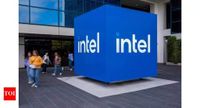In a move that has sent shockwaves through both Silicon Valley and Washington, the United States government has officially acquired a nearly 10% stake in Intel, marking one of the most significant interventions in the American private sector in recent memory. Announced on August 23, 2025, by President Donald Trump, the deal converts $8.9 billion in previously awarded grants and incentives into 433.3 million shares of Intel’s non-voting stock, making the U.S. government one of the company’s largest shareholders at a critical juncture in its storied history.
Intel, once the undisputed king of the global semiconductor industry, has struggled mightily in recent years. The company reported a staggering $18.8 billion loss in 2024 and another $2.9 billion loss in the second quarter of 2025. Amid these losses, Intel is in the midst of a sweeping restructuring plan under CEO Lip-Bu Tan, who was appointed in March 2025. Tan has responded to the crisis by slashing 15% of Intel’s workforce—amounting to almost 25,000 jobs—and canceling ambitious projects, including new factories in Germany and Poland. The company is also spinning off its Network and Edge (NEX) group to refocus on its core businesses.
The government’s investment is not fresh capital but rather a conversion of funds Intel was already slated to receive under the CHIPS and Science Act and the Secure Enclave program. According to the Associated Press, the deal includes $5.7 billion in unpaid CHIPS Act grants and $3.2 billion from the Secure Enclave program, with the shares acquired at $20.47 each—a 17.5% discount to the market price on the day of the announcement. Intel’s stock rallied by more than 5% following the news, closing at $24.80 per share, and the company’s market capitalization now stands at about $108 billion, a fraction of rival Nvidia’s $4.3 trillion valuation.
President Trump, who has previously criticized the CHIPS Act as a “horrible, horrible thing,” nonetheless hailed the agreement as a win for American taxpayers and industry. “The United States of America now fully owns and controls 10% of Intel, a Great American Company that has an even more incredible future,” Trump wrote in a post. He further claimed, “The United States paid nothing for these shares,” arguing that the conversion of grants into equity represents a “great Deal for America and, also, a great Deal for Intel.”
Commerce Secretary Howard Lutnick echoed this sentiment, stating, “America should get the benefit of the bargain.” He explained the administration’s new approach: “It’s not governance, we’re just converting what was a grant under Biden into equity for the Trump administration, for the American people.” This shift ensures taxpayers share in any future upside from public investments in the semiconductor sector.
But the deal is not without controversy. The government’s stake is “passive,” meaning it comes with no voting rights or seats on Intel’s board—a crucial point for the company as it tries to maintain operational control. However, the agreement includes a five-year warrant that allows the government to acquire an additional 5% of Intel’s common shares if the company sells more than 49% of its foundry business, a key part of its manufacturing operations.
Legal experts have already raised questions about whether the CHIPS Act permits the conversion of grants into equity, suggesting the deal could face court challenges. “Overall, it’s a horrendous move that will have real harms for U.S. companies, U.S. tech leadership, and the U.S. economy overall,” warned Scott Lincicome, vice president of general economics for the Cato Institute, as reported by the Associated Press. Nancy Tengler, CEO of Laffer Tengler Investments, was similarly skeptical: “I don’t see the benefit to the American taxpayer, nor do I see the benefit, necessarily to the chip industry.”
The deal also follows a dramatic reversal in President Trump’s stance toward Intel’s CEO. Earlier in August, Trump publicly called for Tan’s resignation over concerns about his past investments in Chinese technology firms. The situation was defused only after Tan met with Trump at the White House and publicly reaffirmed his allegiance to the U.S. In the end, Trump praised Tan as a “highly respected” leader and credited him with negotiating the deal. Tan, for his part, expressed gratitude for the administration’s confidence, stating, “We are grateful for the confidence the President and the Administration have placed in Intel, and we look forward to working to advance U.S. technology and manufacturing leadership.”
The government’s move is reminiscent of its intervention during the 2008 financial crisis, when it acquired a controlling stake in General Motors to prevent the automaker’s collapse. That episode ultimately cost taxpayers about $10 billion, even after the government sold its shares. This time, the Trump administration is betting that the equity-for-funding model will not only stabilize Intel but also ensure the U.S. remains at the forefront of semiconductor technology—a sector seen as vital to national security and economic competitiveness, especially in the race with China for technological supremacy.
Yet, there are doubts about whether the investment can address Intel’s deep-seated technical and strategic challenges. The company’s much-hyped 18A process node, which was supposed to restore its manufacturing leadership, has been beset by production problems and critically low yields. This failure has forced Intel to abandon the node for external customers and pivot its hopes to the next-generation 14A process, which is not expected until late 2027. As Summit Insights analyst Kinngai Chan put it, “We don’t think any government investment will change the fate of its foundry arm if they cannot secure enough customers.”
Former Intel CEO Craig Barrett has also criticized the company’s current strategy, arguing that waiting for customer orders before investing is a recipe for failure in the fiercely competitive chip industry. “To win in this space you need to be the leader in technology not the follower,” Barrett said.
Despite these challenges, the deal has its supporters. Tech leaders like Microsoft’s Satya Nadella and Dell’s Michael Dell praised the move for strengthening the U.S. supply chain, and President Trump touted the agreement as “fundamental to the future of our nation.” The administration is also requiring Nvidia and Advanced Micro Devices to pay a 15% commission on chip sales to China in exchange for export licenses, part of a broader push to bring semiconductor production back to U.S. soil and reduce reliance on overseas factories.
With the U.S. government now a major shareholder, Intel’s fate is more than ever intertwined with national policy. Whether this unprecedented public-private partnership will deliver the technological renaissance America hopes for—or become another costly experiment—remains to be seen. For now, the world is watching as Intel, with Washington at its side, tries to engineer one of the most ambitious corporate turnarounds in tech history.


